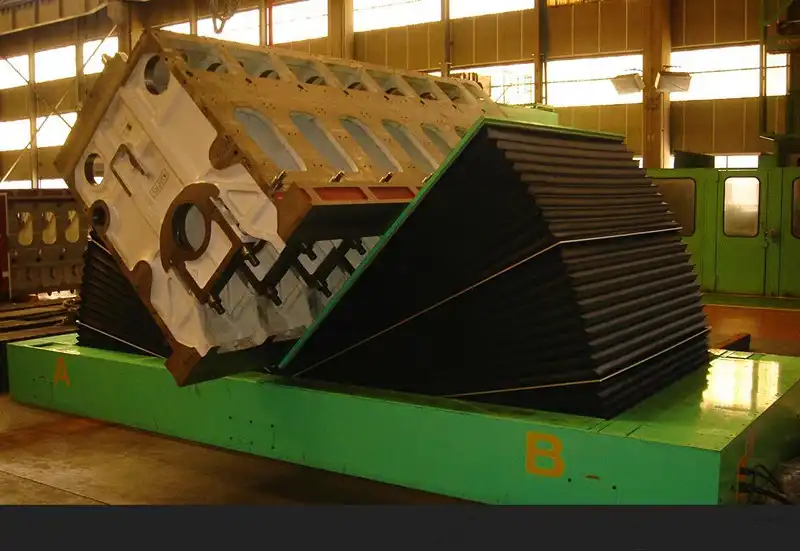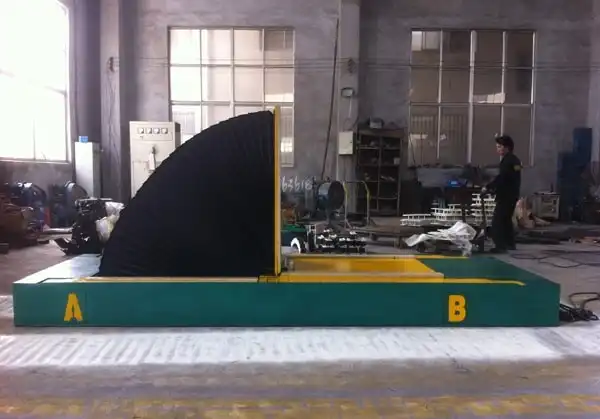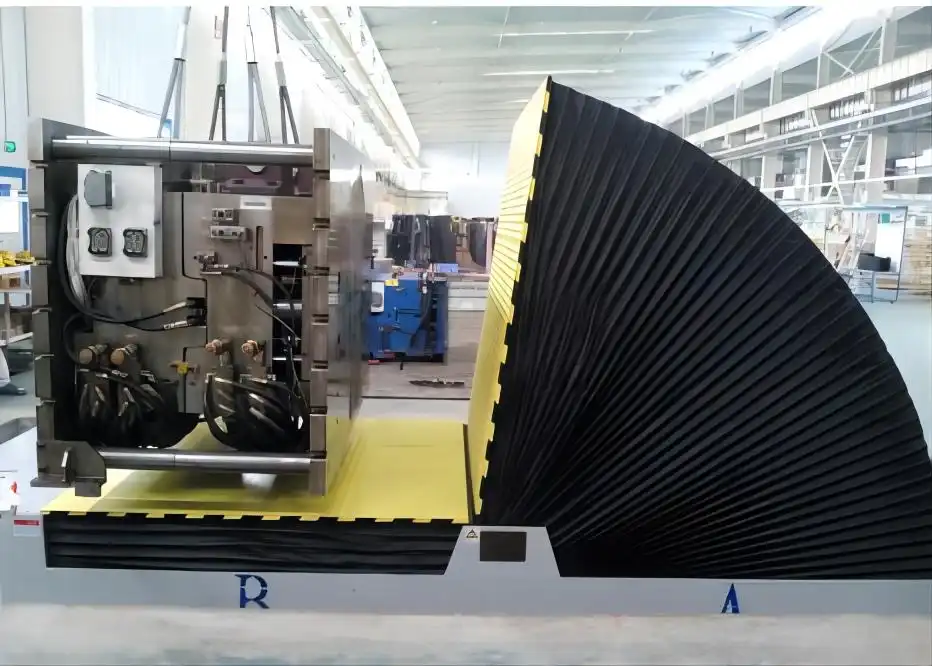Why Mexico’s Procurement Managers Choose Mold Flipper for Heavy Mold Handling
Handling multi-ton molds in a busy steel mill is a constant challenge. You rely on overhead cranes, which are slow and tie up critical equipment. Every manual flip with chains and slings is a risk, a potential point of failure that can lead to catastrophic accidents, damage to expensive molds, and costly production delays. This process is a major source of inefficiency and a safety concern that keeps plant managers and owners awake at night.
Procurement managers in Mexico's demanding steel industry choose mold flippers because they offer a dedicated, safer, and more efficient solution for handling heavy molds. This specialized equipment dramatically reduces the risk of accidents, protects valuable molds from damage, and frees up overhead cranes for their primary lifting tasks, directly improving overall plant productivity and lowering operational costs.

I have spent my entire career in and around packing and handling equipment. I’ve seen firsthand how a single, well-chosen machine can transform a plant's workflow. It’s not just about buying a new piece of steel; it's about solving a fundamental problem. The decision to move from a traditional, risky process to a modern, engineered solution is a critical step for any forward-thinking operation. For leaders in Mexico's steel sector, who are constantly battling costs and pushing for efficiency, the mold flipper isn't a luxury. It's a necessity. But how does this translate into tangible benefits that a CEO or a procurement manager can justify? Let's break it down.
How Can a Mold Flipper Directly Address Rising Operational Costs in a Mexican Steel Mill?
In Mexico, unpredictable energy and fuel prices are a constant pressure on your bottom line. Every operational decision has a direct impact on your production costs. Using a massive, high-power overhead crane for a simple task like turning a mold is an inefficient use of energy and a waste of a critical asset. This not only drives up your electricity bill but also creates a bottleneck, as the crane is unavailable for its main job of moving materials and products, leading to lost time and money.
A mold flipper directly addresses rising operational costs by being significantly more energy-efficient than a general-purpose crane. It also drastically cuts down on labor hours required for the task, frees up your most valuable lifting assets, and virtually eliminates the risk of costly damage to molds, creating savings across energy, labor, and asset maintenance.

A Practical Look at Cost Reduction
When I talk to plant owners like Javier Morales, the conversation always comes back to the numbers. A decision to invest must be backed by a clear return. The cost-saving argument for a mold flipper is one of the strongest I've seen. It’s not a single benefit, but a collection of efficiencies that compound over time. Let’s dissect these cost-saving pathways.
First, let's talk about energy consumption. An overhead crane in a steel mill is a powerful machine, designed to lift enormous loads over long distances. Its motors consume a significant amount of electricity with every use. Using it to perform a 90-degree flip on a mold is like using a sledgehammer to crack a nut. A mold flipper, on the other hand, is an engineered system designed for one purpose. Its motors and hydraulic systems are sized perfectly for the task of rotating a load on a fixed axis. The energy used is a fraction of what a crane consumes for the same job. Over hundreds of flips per year, this difference in energy cost becomes substantial.
Second is the impact on labor and time. The traditional crane method is a slow, careful dance. It requires at least one certified crane operator and often one or two riggers on the ground to manage the chains and slings. The process of rigging, lifting, slowly turning, and un-rigging can take a long time. A mold flipper simplifies this to a one-person operation that takes seconds. The operator loads the mold with a forklift, pushes a button, and the flip is complete. The time saved per flip is enormous. When you multiply that by the number of mold changes you do, you are reclaiming hundreds of valuable man-hours a year.
Finally, consider the cost of asset protection. A steel or die-casting mold is a high-value, precision-engineered tool. Damaging one can lead to repair costs in the tens of thousands of dollars, not to mention the massive cost of the production line being down while you wait for the repair or replacement. The uncontrolled nature of flipping with chains carries a constant risk of the mold being dropped, dented, or scratched. A mold flipper secures the mold to a stable platform and performs a smooth, controlled rotation. It practically eliminates the risk of damage.
| Metric | Traditional Crane Method | Mold Flipper Method |
|---|---|---|
| Time per Flip | 15-30 minutes | 1-2 minutes |
| Labor Required | 2-3 personnel (operator, riggers) | 1 person (forklift operator) |
| Energy Usage | High (large crane motors) | Low (optimized, smaller motors) |
| Risk of Mold Damage | High (dynamic load, chains/slings) | Very Low (secured, controlled rotation) |
| Crane Availability | Blocked during operation | Unaffected, free for other tasks |
What Makes a Mold Flipper a Safer and More Reliable Choice Than Traditional Cranes for Aging Equipment?
Plant safety is not just about compliance; it's about protecting your people. Using aging cranes, which may already have higher failure rates, to perform a delicate and dangerous task like flipping a heavy, unbalanced mold is a significant liability. One worn-out sling, one moment of operator misjudgment, or one unexpected load shift can lead to a devastating accident. This constant risk puts stress on your team and your entire operation.
A mold flipper is inherently safer and more reliable because it transforms a dynamic, high-risk lifting operation into a controlled, automated process. By securing the mold to a stable platform and rotating it on a fixed axis, it removes the variables of human error, sling integrity, and load balance that make crane-flipping so dangerous.

A Deep Dive into Safety and Reliability
Early in my career as an engineer, I witnessed a near-miss where a multi-ton die slipped in its rigging during a crane flip. No one was hurt, but the image of that massive piece of steel shifting unpredictably has stayed with me forever. It’s why I am so passionate about engineered solutions that take the danger out of these everyday tasks. For a leader concerned with both safety and the reliability of aging equipment, a mold flipper is a clear step forward.
The core safety benefit comes from controlled motion. When you lift a mold with a crane and chains, you are dealing with a suspended load. It can swing and twist. The center of gravity can shift unexpectedly. The entire operation depends on the skill of the rigger and the crane operator. A mold flipper eliminates this chaos. The mold is placed on a solid table, clamped securely, and then rotated. The entire process is predictable and contained within the machine's footprint. The operator is standing at a safe distance, controlling the machine with a simple interface, not standing near a suspended load.
This directly leads to a reduction in human error. Complex rigging and coordinated lifting maneuvers have multiple points of potential failure. A mold flipper simplifies the task to loading an object and pressing a button. This automation doesn't just make the process faster; it makes it consistently safe, time after time. It removes the most unpredictable element from the safety equation: human variability.
Furthermore, it improves the reliability of your entire plant, especially when dealing with aging equipment. Your older cranes are already under stress from years of service. Asking them to perform high-risk, off-balance lifts adds unnecessary wear and tear to their structural and mechanical components. By offloading this specific task to a new, dedicated machine, you reduce the strain on your critical crane assets. This can extend the life of your cranes and reduce their maintenance needs, directly supporting a goal of increasing equipment uptime to 95%.
| Safety & Reliability Factor | Traditional Crane Method | Mold Flipper Method |
|---|---|---|
| Load Stability | Unstable; suspended and dynamic | Stable; secured to a platform |
| Operator Proximity | Close to suspended load | At a safe distance, at a control panel |
| Required Skill Level | High (certified operator, skilled riggers) | Low (basic operator training) |
| Points of Failure | Multiple (slings, hooks, crane, operator) | Minimal (machine components) |
| Process Consistency | Varies with operator/crew | Highly consistent and repeatable |
How Does a Modern Mold Flipper Support a Steel Mill's Digital Transformation and Productivity Goals?
You are investing heavily in a digital future. You're implementing Manufacturing Execution Systems (MES) and IoT sensors to gain full visibility of your production floor. The problem is that manual, offline processes like mold maintenance create black holes in your data. You cannot measure, and therefore cannot optimize, what you cannot see. This data gap can derail your entire smart scheduling system, undermining your goal to achieve 95% equipment uptime.
A modern mold flipper supports digital transformation by turning a manual bottleneck into a predictable, measurable, and automatable process. It provides consistent cycle times for accurate scheduling in an MES, can be equipped with sensors to provide real-time status data, and automates a critical step in mold changeover, directly boosting productivity and enabling true production visualization.

Integrating a Mold Flipper into the Smart Factory
The push for digitalization is something I see across all heavy industries, and it's a journey I am passionate about helping my clients navigate. A smart factory is only as smart as its weakest link. A mold flipper, while seemingly simple, is a powerful enabler of a larger digital strategy.
The first and most immediate benefit is predictable cycle times. A key goal for any modern plant is accurate scheduling. The time it takes to flip a mold with a crane can vary wildly depending on which crane is available, which crew is on duty, and other factors. It’s an unpredictable variable. A mold flipper has a fixed, consistent cycle time—often 60 to 90 seconds. This predictable number can be programmed directly into your MES. Your planning software now knows exactly how long that part of the mold changeover process will take, making the entire production schedule more accurate and reliable.
Next is direct data integration. Modern mold flippers are not just dumb machines. They can be fitted with sensors that communicate with your plant's network. These sensors can send simple, crucial signals: "Machine Idle," "Mold Loaded," "Flip in Progress," "Flip Complete." This data flows into your MES or data platform, giving you a real-time, granular view of your mold maintenance bay. You eliminate a blind spot and get one step closer to comprehensive production visualization.
This automation directly addresses a common production bottleneck. In many steel mills and manufacturing plants I've visited, the mold preparation and changeover process is the single biggest cause of planned downtime. By automating and speeding up the flipping step, you accelerate the entire sequence. This reduction in changeover time is pure productivity gain. It means your production lines are running for more minutes every day, directly increasing your plant's capacity utilization rate. It’s a simple change that has a massive ripple effect on overall output.
| Digital & Productivity Goal | Traditional Method Challenge | Mold Flipper Solution |
|---|---|---|
| Increase Uptime to 95% | Long, unpredictable changeovers | Fast, consistent cycle times reduce downtime |
| Implement Smart Scheduling | Variable process time creates errors | Fixed cycle time allows for precise planning in MES |
| Achieve Production Visualization | Manual process is a data "black hole" | Can be integrated with sensors for real-time status tracking |
| Reduce Bottlenecks | Crane availability limits workflow | Dedicated machine streamlines mold prep |
Why is a Mold Flipper More Than a Machine, But a Strategic Investment?
As a CEO or plant owner, you aren't just buying equipment; you are making strategic investments that should deliver value for years. It's easy to look at a mold flipper and see it as a simple piece of machinery to solve a small problem. But this view misses the bigger picture. Ignoring these foundational operational improvements is how small inefficiencies add up over time, eroding your profit margins and preventing you from hitting ambitious cost-reduction goals.
A mold flipper is a strategic investment because it fundamentally de-risks a core operational process, unlocks hidden capacity in your most expensive assets, and serves as a catalyst for a safer, more modern, and data-driven manufacturing culture. It's an investment in stability, efficiency, and future growth.

The CEO's Perspective: Beyond the Spec Sheet
My own journey from being an employee in a factory to owning one taught me a crucial lesson: the best investments are the ones that solve a nagging problem today while creating a new opportunity for tomorrow. This is the lens through which a leader like Javier should view the mold flipper. It's not just a capital expenditure; it's a strategic move.
First, it is a powerful tool for operational de-risking. As a leader, you manage many types of risk. There's financial risk, but there's also operational risk from unplanned downtime and, most importantly, reputational risk from safety incidents. A serious accident can damage your company's standing in the community and with your clients. The mold flipper directly mitigates all three by making a dangerous process safe, reliable, and predictable.
Second, and perhaps most importantly from a strategic view, is asset optimization. The true ROI of a mold flipper isn't just in its own efficiency; it's in the efficiency it unlocks across the plant. Your overhead crane is a massive capital asset. Every minute it spends doing a low-value task like flipping a mold is a minute it's not doing its primary, high-value job of moving raw materials and finished products. By freeing up your crane, a mold flipper can effectively increase your entire plant's throughput. It unlocks hidden capacity without the multi-million dollar investment of a new crane.
Finally, it's a tangible step in your digital transformation and cultural modernization. When you bring in smart, modern equipment that makes work safer and easier, you send a powerful message to your workforce. It shows a commitment to their well-being and to the company's long-term success. It is a foundational piece of equipment that can be integrated into your future smart factory. When I partner with a company, the discussion is never just about the machine's turning speed. It’s about how this machine fits into the five-year plan. It’s about becoming a partner in their journey toward a safer, more profitable future.
| Strategic Pillar | Short-Term Impact | Long-Term Value |
|---|---|---|
| Operational De-risking | Eliminates a major safety hazard | Lower insurance costs, improved reputation |
| Asset Optimization | Frees up overhead crane | Increased overall plant throughput and capacity |
| Digital Transformation | Automates a manual process | Foundation for data integration and smart scheduling |
| Workforce Engagement | Improves worker safety and morale | Higher retention and a culture of modernization |
Conclusion
A mold flipper is a smart, strategic investment for any Mexican steel mill, boosting safety, efficiency, and profitability. It is the total solution for modern mold handling.




